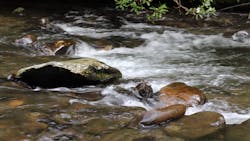A new nationwide study by U.S. Geological Survey (USGS) scientists provides additional scientific evidence that pesticides are likely negatively impacting aquatic invertebrate community health and therefore the health of U.S. stream and river ecosystems, according to a USGS press release.
The USGS used multiple research strategies from statistical modeling to laboratory experiments to sampling in more than 400 streams across the United States. Scientists determined that four pesticides — bifenthrin, chlordane, fipronil and imidacloprid — were each likely impacting the health of aquatic invertebrates at the regional scale in at least one of the five regions studied.
Pesticides are used in agricultural and urban environments to control a variety of pests including invertebrates such as insects, mammals such as rodents, fungi, algae, and plants. They act through a variety of modes on the target organism; however, non-target organisms are often affected either through direct toxicity or secondary or indirect impacts to prey species or habitat. Overspray, drift, and runoff may carry a pesticide far from its application site.
Aquatic ecosystems are critical to the economy and communities, providing sources of drinking water, buffering communities against storms through wetland and marsh areas, driving vast sportfishing and recreational industries, and filling a host of other functions. Invertebrates are keystone species in those river and stream ecosystems. They are also already impacted by other environmental stressors in their environment, such as habitat degradation and changing temperatures, therefore they may be particularly sensitive to pesticide effects.
As part of the study, scientists sampled water, bed sediment and invertebrates to assess their exposure to pesticides. Knowing that pesticides are present in their environment and that aquatic invertebrate communities are struggling does not alone mean that pesticides are the cause. Therefore, scientists needed to investigate a variety of forms of evidence to determine the likelihood that pesticides were negatively impacting aquatic invertebrates in U.S. streams.
The research in this study used multiple lines of investigation to gather evidence. This included:
- Toxicity predictions based on measured pesticide concentrations in streams.
- Statistical analyzes that tested the relationship between pesticides and invertebrate communities in streams.
- Multivariate models that identified which pesticides best explained the invertebrate community structure and health.
- Experiments using “mesocosms,” which are aquatic invertebrates brought into the laboratory and dosed with pesticides under controlled conditions to demonstrate the impacts these pesticides have.
“Stream invertebrates are impacted by many environmental stressors, including pesticides, habitat disruption, and changing temperatures, especially in streams that include agricultural or urban land in the watershed. Since many stressors are present, it has been difficult to determine the degree to which pesticides negatively affect stream invertebrates,” said Lisa Nowell, emeritus research chemist with the U.S. Geological Survey. “Looking at data from a variety of different study elements across 400 streams nationwide has not proven causality but has drawn a closer link between pesticides and their likely impact on aquatic invertebrates. Overall, this study makes a strong case that pesticides are a likely cause of harm for invertebrates in U.S. streams. Further, our findings suggest that stream biomonitoring and assessment efforts would benefit from the addition of pesticide monitoring.”
This information can be used by researchers and regulators investigating water quality as a stimulus for future research investigating stream degradation and as an aid to those tasked with remediation or restoration of streams.
The study, titled “Multiple lines of evidence point to pesticides as stressors affecting invertebrate communities in small streams in five United States regions” was published in Science of the Total Environment on January 24, 2024.






